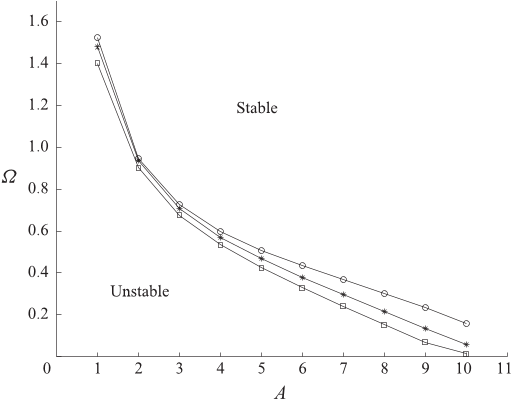




Did you find this useful? Give us your feedback










35 citations
... the same order as the dissipation, hence at the ΓM/f = O(ǫ2), and the resulting envelope equation at third-order in the wave steepnessǫ is given by a wind-forced nonlinear Schrödinger (NLS) equation [12, 8, 22] of the form i ∂a ∂t −β1 ∂2a ∂x2 − M|a|2a = i ΓM 2 −2νk2 ! a (1) where β1 = −(dcg/dk)/2 = ω/(8k2), M = ωk2/2, and ν is the kinematic viscosity. Recently we have derived the wind-forced NLS for stronge...
[...]
...compare with results obtained when considering growth rates at the first order in steepness. By defining τ = ωt, ξ = 2kx, Γ = ΓM/(2ω), δ = 2νk2/ω, K = Γ −δ, and A = ka/ √ 2, the equation (1) reduces to [8] iAτ − 1 2 Aξξ − A|A|2 = iKA (3) The factor K on the right-hand side can be positive, null or negative depending on the relative importance of the viscosity term δ with respect to the wind-forcing ter...
[...]
...equations) to obtain mathematical models for the propagation of surface gravity waves which can be handled analytically. The wind can induce either damping or forcing terms in the resulting equations [12, 8] depending on its speed and direction relative to the wave propagation. Many experiments have been performed to investigate how surface waves and modulational instability are affected by wind and dissi...
[...]
...stability properties of the wavetrains rely on the form of the damping/pumping terms in the governing equations which, in the context of water waves, depend on the wind providing energy to the system [6, 7, 8]. Modeling the effects of wind on ocean waves is a very complex task due to turbulence in both the atmospheric and the oceanic boundary layers, and nonlinearities in the propagation of the gravity wave...
[...]
...eq. (3) independent on ξ, is given by AS (τ) = A0 eKτe−ib(τ) , b(τ) = |A0|2 2K (e2Kτ −1) (4) Note that for K = 0, we get b(τ) = |A0|2τ, which is valid in the inviscid case. Following previous studies [15, 12, 8], the Stokes-like wave is perturbed as follows A(ξ,τ) = AS (τ)[1 +δ0 ζ(ξ,τ)] (5) with δ0 infinitesimal and ζ(ξ,τ) = M(ξ,τ) +iN(ξ,τ). Substituting into eq. (3) gives the following system of equations Mτ...
[...]
31 citations
...Kharif et al. (2010) combined the effects of wind and dissipation in the NLS equation and demonstrated that this combination has a cumulative effect on the modulation evolution....
[...]
25 citations
23 citations
22 citations
...Recently,Kharif et al. (2010) used a forced and damped version of the nonlinear Schrödinger equation i ( ψt +Cgψx ) − ω0 8k20 ψxx − 2ω0k 2 0|ψ | 2ψ = i Wω0k0 2gρ ψ − 2iνk20ψ (1) to investigate both damping and amplification effects on the Benjamin-Feir instability....
[...]
...Kharif et al.(2010) found that the stability of the envelope depends on the frequency of the carrier wave and the friction velocity of the wind over the waves and plotted the critical curve separating stable envelopes from unstable envelopes....
[...]
...Based on this assumption,Kharif et al. (2010) derived a forced and damped nonlinear Schrödinger equation (fdNLS) and extended the analysis ofSegur et al. (2005a) when wind input is introduced....
[...]
...Within the framework of the NLS equation,Kharif et al. (2010) showed that the wave train is unstable to modulational instability for these values ofA and ....
[...]
...2, we remind the main results obtained by Kharif et al. (2010)....
[...]
8,808 citations
4,774 citations
2,425 citations
2,109 citations
...Later on, Benjamin & Feir (1967) showed analytically that Stokes waves of moderate amplitude are unstable to small long-wave perturbations travelling in the same direction....
[...]
1,428 citations
The evolution of a two-dimensional nonlinear wave train on deep water, in the absence of dissipative effects, exhibits the Fermi–Pasta–Ulam recurrence phenomenon.
Since damping affects the modulational instability of waves in deep water, they assumed that it might affect the early development of rogue waves.
For an energy flux to occur from the wind to the water waves, there must be a phase shift between the fluctuating pressure and the interface.
The present paper is aimed at reporting on the behaviour of Benjamin–Feir instability when dissipation and wind input are both taken into account.
In the presence of wind and dissipation, the unstable domain shrinks for low-frequency regime: this means that young waves are more sensitive to modulational instability than old waves.
Email address for correspondence: kharif@irphe.univ-mrs.frnearly uniform wave trains become modulated and then demodulated until they are again nearly uniform.
when the perturbations are small initially, they cannot grow large enough for nonlinear resonant interaction between the carrier and the sidebands to become important.
Since Stokes (1847), it is well known that the potential water wave problem admits as solutions uniform wave trains of two-dimensional progressive waves.
This situation was discussed by Segur et al. (2005a, see their comment (iii) p. 238), and it was claimed that even with substantial growth of the perturbation, the Stokes solution of (3.4) is still linearly stable: it is always possible to find a gap (denoted ∆) between unperturbed and perturbed solution that satisfies the linear stability criterion.